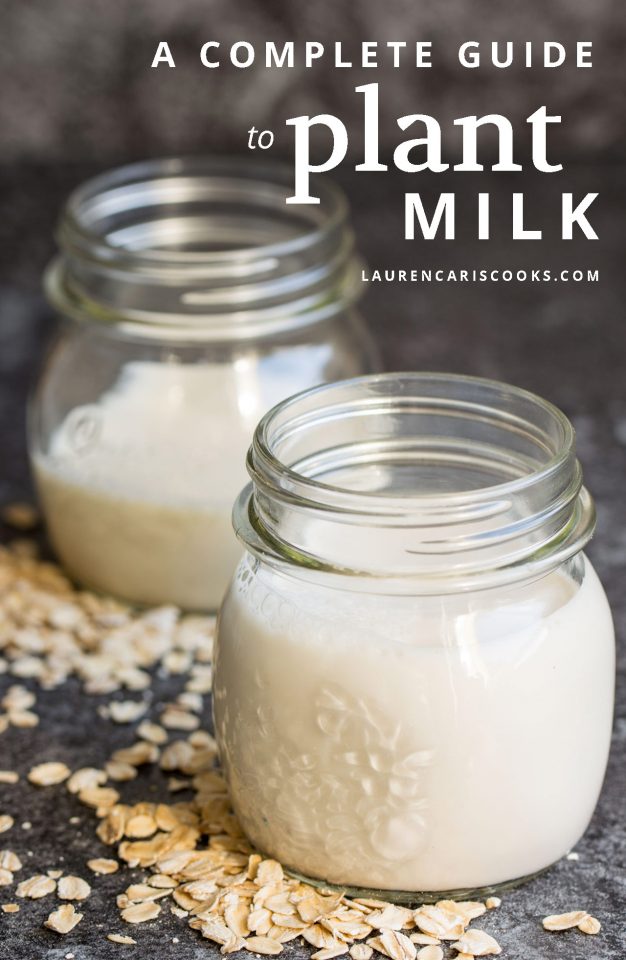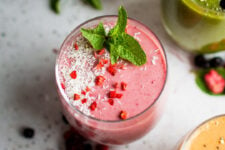Non dairy milk is becoming an increasingly popular choice, not exclusively to vegans. Those who are lactose intolerant are now looking for more alternatives than just soy milk, and those concerned with cholesterol and heart disease are making the switch too.
But not all non dairy milks are created equal. In this post I’m going to give you a full profile overview of five of the most common plant based milks, and answer some questions that go beyond health benefits.

This post is certainly not a direct comparison of these plant milks, because frankly, they all have pro’s and con’s and there are limited studies on direct comparisons of plant milks in controlled conditions. I am simply laying out some information about different kinds of non dairy milk, so that you can have a deeper understanding of where plant milks come from, what’s really in them, and the impact they have on the environment.
Dairy milk, is nature’s perfectly designed food… for a baby CALF. The most commonly promoted benefits of drinking cow’s milk include the high protein content, calcium, phosphorous and magnesium. That’s great, but we are able to obtain sufficient levels of all of these things from plant based foods, so what are some of the more undesirable things you are getting from cow’s milk, that you may not know about?
Antibiotics – Cow’s are typically pumped full of antibiotics, which end up passing through to the milk. Antibiotic resistant bacteria is already a growing problem in the world that doesn’t need to be added to by the dairy industry. And just to preempt the point that organic cows are not given antibiotics, while this is true, it often means that the cows are left in poor conditions without treatment for infections and other ailments, making their life unnecessarily painful in order to tick the “organic” box.
Cholesterol – A typical serving of milk contains 24 mg of cholesterol.
D-galactose – A scientific study (click here to read) suggests that the concentration of lactose and D-galactose in milk actually increases the risk of bone fractures, which is contradictory to the general advice that milk helps “make your bones grow stronger”.
In this blog post, we’re going to look at soy, almond, rice, oat and coconut milk. We will cover five areas of each milk, including the production process, health information, sustainability, and it’s best uses. So let’s jump in!
Soy Milk
Ingredients
Soybeans and water. Most manufactures normally fortify soy milk with vitamins and other nutrients such as vitamin D, B vitamins and calcium. Sometimes sugar and salt are also added, especially in flavoured versions such as chocolate and vanilla and any other speciality ranges.
Production
Soybeans are indigestible by humans in their raw state, and must therefore go through an intense cooking process before they can be consumed. This process also assures that any harmful bacteria are eliminated from the beans, as they are an ideal breeding ground for bacteria when raw.
First, the hulls of the soybean are removed using a large vacuum, the soybeans are then cooked at an extremely high temperature to remove any harmful bacteria. The beans then go through a 2 step grinding process, to separate the non edible element of the bean. The non edible element is called “okara” and it is then dried and sent for uses other than human consumption.
The remaining liquid is then blended and sterilised, before being cooled and packaged. Any flavours and extra vitamins are added during the blending process. The packaging process for soy milk has been carefully constructed so that the milk is not exposed to air and possibly contaminated with bacteria.
Useful information about soy milk production
Health
Soy milk is a good source of protein, comparable to cow’s milk, yet is lower in calories.
It also contains no cholesterol so is a good option for those concerned about heart disease.
There have been concerns over the long term effects of too much soy consumption. I have read up on this quite a bit, but it’s difficult to give a conclusive answer either way. Personally, I’m not soy-phobic, I enjoy eating tofu and soy based products a couple of times a week for the protein benefits. I don’t personally drink soy milk, but that’s down to taste preference for me. I’ve included a link below to a couple of resources showing both sides of the soy-argument.
Harvard University – “Straight Talk About Soy”
Information from Legit Nutrition Hawaii on Soy consumption
Concerns about the health implications of high soy based product consumption
Sustainability
The production of soy for animal feed is a large factor to be considered in the issue of habitat destruction. Until recently, the large amount of waste (okara) produced during the soy milk production process had nowhere to go. Now this is dried and often sent to farms to be used as animal feed, so the waste is somewhat reduced. However it seems a vicious cycle that the production of soy milk and it’s by products are further feeding the animal agriculture industry, which is causing so much damage to the environment in itself.
In 2010, a group of scientists co-authorored a report called “GM Soy: Sustainable? Responsible?”, which summarises more than 100 independent studies showing the health and environmental hazards of genetically modified (GM) soy. GM soy accounts for a huge amount of the soy industry production, and the consequences of this production cannot be ignored. If you buy soy milk, always opt for an organic, non GM version.
“GM Soy: Sustainable? Responsible?”: Summary
“GM Soy: Sustainable? Responsible?”: Full Report
Uses
Soy milk is probably the most common replacement milk used in mainstream places. Starbucks for example have offered soy-milk as an alternative, and only recently are other plant milks becoming an option. Soy milk works well in hot drinks, on cereal, in oatmeal and baking.
Almond Milk
Ingredients
Almonds (typically 2% or more), Water. Can also include sugar, salt, Sunflower Lecithin, Gellan Gum. Calcium Carbonate, Vitamin E Acetate, Zinc Gluconate, Vitamin A Palmitate, Riboflavin (B2), Vitamin B12, Vitamin D2.
Production
Almonds are blended with water using large scale blenders, and then the almond pulp is drained. The water left behind is the milk.
Health
Almonds are one of the healthiest foods around. They are packed with protein, minerals, vitamins, healthy fats and fibre. It would be easy to assume that almond milk also comes packed with all the same benefits, but the problem is the low percentage of almond actually found in almond milk.
Most brands contain only around 2% almonds, with the largest volume ingredient being water. A lot of almond milk also contains quite a lot of sugar, still less than cow’s milk, meaning it contains less calories, but it’s always better to go for an unsweetened, unflavoured version where possible.
From a health perspective, almond milk is a good choice, but don’t expect to get all the nutrients you would get from eating whole almonds. Alternatively, make your own! It’s actually an incredibly easy plant milk to make yourself.
A great almond milk recipe, with suggestions on what to do with the leftover pulp!
Sustainability
This is where almond milk falls down. It takes around 1.1 gallons (5.5 litres) of water to grow just one almond. With over 80% of the world’s almond crops in California, where they are experiencing huge water shortage issues, this does pose a long term problem. With the popularity of almond milk, and therefore the profits, constantly rising, almond crops are still being planted and grown all the time.
Even though 100ml of almond milk takes less water to make than 100ml of cow’s milk, the issue here lies with the uneven distribution of the crops.
Unfortunately bees also suffer quite badly from intense almond tree farming. All those trees need to be pollinated, which means a huge amount of hives are brought to California every year. These bees are then exposed to a lot of pesticides and insecticides, which spells disaster for this already suffering species.
Uses
Because almond milk is so thick and creamy, it works really well as a replacement milk in most instances. The only thing I’ve found it’s not so great in is hot drinks. Now, that being said it works extremely well if you’re trying to make a milk based drink such as a latte or a hot chocolate, but I’m talking when you just want a splash of milk in your coffee. In those instances it leaves a bit of an oily residue on top of the drink which I don’t like.
Rice Milk
Ingredients
In its purest form, rice and water. Most brands of rice milk seem to be loaded with sugar and synthetic vitamins.
Production
The production of rice milk is a fairly straightforward process. It is made by pressing the rice through a mill using diffusion, in order to strain out any remaining whole grain pieces. It is also one of the easiest plant milks to make at home, simply by boiling rice with a large volume of water, blending and then straining the mixture.
Health
As rice milk is predominantly a carbohydrate, it makes for a great energy boost. Other than that, it doesn’t have as many natural vitamins and minerals as say, almonds, and it is often fortified with a lot of synthetic vitamins.
There are some suggestions that synthetic vitamins are not well absorbed by the body, and the body also has to expend a fair amount of its nutrient stores to go through that process. So it can actually cost you nutrients to absorb synthetic ones. In my mind… not worth it. You’re always better off eating produce that has nutrients occurring naturally, than eating fortified foods.
Rice milk is much lower in protein than cow’s milk, or soy milk, so you would need to make sure you were eating adequate protein from other sources.
Sustainability
Rice is probably the most intensively farmed grain in the world, and being grown in flooded plains obviously requires a lot of water, which can be contaminated, although this is somewhat controlled and tested. New varieties of rice may involve less intensive farming, but may also be GM, so that’s something be considered.
Uses
Rice milk is naturally quite sweet, so works well on cereal, in smoothies and as a replacement milk in desserts. I really dislike the taste of rice milk in hot drinks, it gives a strange, artificial sweetener taste to the drink, and I’d rather have no milk than that!
Oat Milk
Ingredients
Oats, Water. Often more vitamins are added to commercial brands.
Production
In commercial oat milk, the production process starts with milling, followed by enzyming to break down the oat starches into smaller components. The bran is then separated from the oats, leaving behind the loose fibres. Then, if relevant other flavourings and ingredients are added, such as vitamins. The milk is then sterilised before being packaged.
Health
Oat milk is one of the most nutritious plant milk options out there. It is very low in fat, but actually contains more calcium per serving than cow’s milk. It’s also a great source of Vitamin A and iron. One serving of oat milk can contain 36% of the daily recommended calcium intake, whereas whole milk only provides 28%. This is a great way to get some calcium in if you’re vegan or lactose intolerant. All in all, oat milk is a pretty good choice health wise.
Sustainability
A Swedish study suggests that Oat Milk’s carbon footprint is just a fraction of regular dairy. It definitely seems to be one of the more sustainable plant milk options out there.
Uses
In terms of taste and uses, oat milk is my personal favourite. It doesn’t curdle when added to hot drinks, can be used in the same quantities as dairy in baking and tastes great in smoothies and oatmeal. All round, for me oat milk is a winner.
Coconut Milk
Ingredients
Water, coconut cream.
Production
The flesh of the coconut is grated, placed in hot water and soaked. The coconut cream rises to the top and can be skimmed off. The remaining liquid is drained. Each draining makes the coconut milk a bit thinner. The thicker versions are used for creams and desserts, and the thinner versions more closely resemble everyday milk.
Health
Coconut milk is quite high in fat. Coconuts are rich in fibre, vitamins C, E, B1, B3, B5 and B6 and minerals including iron, selenium, sodium, calcium, magnesium and phosphorous. While the fat from coconuts is by no means unhealthy, professionals recommend consuming coconut milk in moderation.
Sustainability
According to this chart coconut milk carries the lowest carbon footprint of all the milks we have looked at, but it’s worth noting that ALL these options carry a far lower carbon footprint than dairy milk.
Uses
Coconut milk can be used quite well as a substitute for dairy in most ways. It can have a mild coconut taste, so that is something to bear in mind if you’re not a fan of that flavour.
Conclusion
So there we have it, a broad overview of five of the most popular pseudo-milks out there. All have their pro’s and cons, particularly when it comes to sustainability, but it’s clear that even the most unsustainable plant milks have less of an impact on the environment than dairy milk.
As for the health benefits, some are more nutrient rich than others, and it’s probably sound advice to not suggest sticking to one option solidly. Our bodies perform best when fed a variety of foods every day, and combining foods in different ways.
There’s also the concern about how many additives and artificial sugars are added to most mass produced plant milks, and with how easy some of them are to make yourself, I would highly recommend this as an option. By buying things in their whole form, they are much more pure (and sustainable) than buying a version that has been processed, packaged and manipulated.
What are your thoughts on plant milks? Do you have a favourite? Are there any other varieties that you enjoy that I haven’t mentioned? Let’s discuss . . .







The extensive amount of information you put forth in forming this incredible milk-related guide is truly a remarkable revelation for the lot of us. I must say that if they were to give out awards for informative articles such as this, you would surely deserve a food oscar.
Prof.Dr. A.A.Qureshi,
Islamabad, Pakistan.
Thanks so much Ashfaq, that’s so kind and I’m glad you found it useful!
It’s awesome how much research you put into this and have given such a balanced and informative view. Thanks so much for making it so easy to find all the pros and cons of each plant milk!
Thanks Ben, so glad you found it useful!
Thanks Ben, so glad you found it useful!